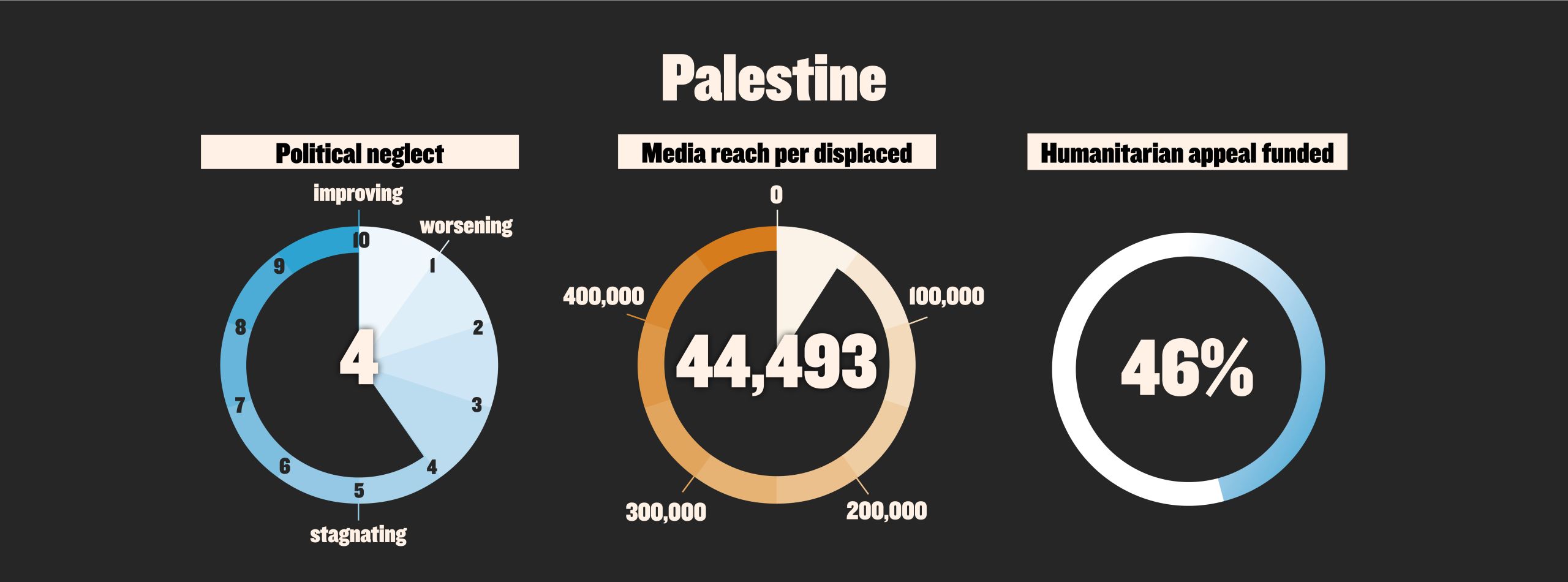The world’s most neglected displacement crises
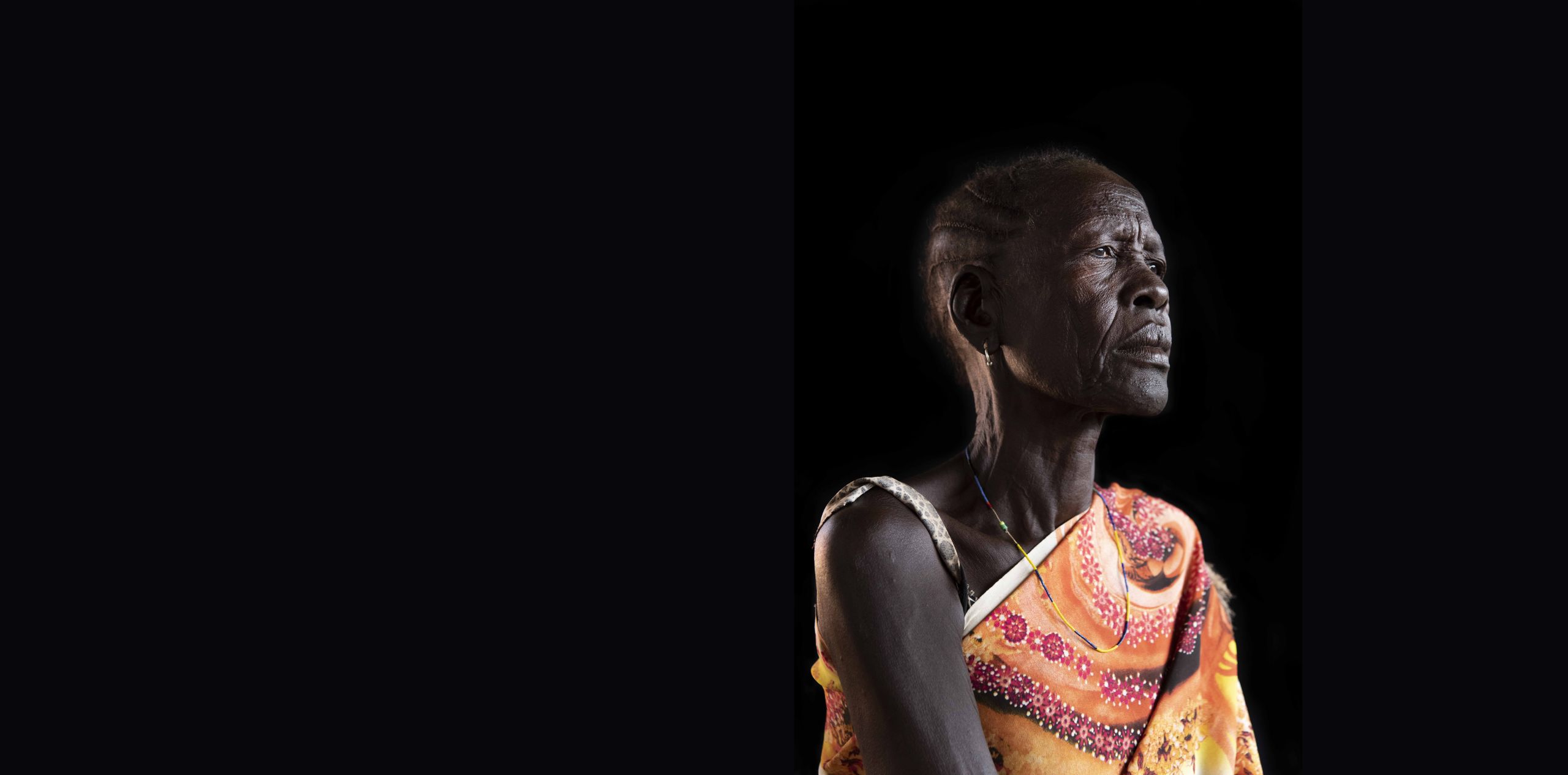
Millions of people affected by humanitarian crises fail to get the support they need and deserve. Only by drawing attention to these crises can we create change.
Every year, the Norwegian Refugee Council (NRC) publishes a list of the ten most neglected displacement crises in the world. This is the list for 2018.
Although humanitarian assistance should be based on needs, and needs alone, some crises receive much more attention and support than others. Why is one person’s suffering an international priority – resulting in conferences, mediation efforts and donations – while another person’s suffering, in another part of the world, goes unnoticed?
This neglect can be a result of a lack of geopolitical interest. Or the people affected may seem too far away and too difficult to identify with. Neglect can also be a result of competing political priorities and a lack of willingness to compromise, creating a protracted crisis and growing donor fatigue.
Our goal, in issuing this list, is to focus on the plight of people whose suffering rarely makes international headlines. People whom politicians have forgotten or disregarded. People who currently do not receive the support and protection they deserve and need.
We believe that more information and knowledge about these people, and the crises surrounding them, is a first important step towards change.
We have created our list based on the following three criteria: lack of political will, lack of media attention and lack of economic support. All* displacement crises resulting in more than 200,000 displaced people have been analysed – 36 crises in total.
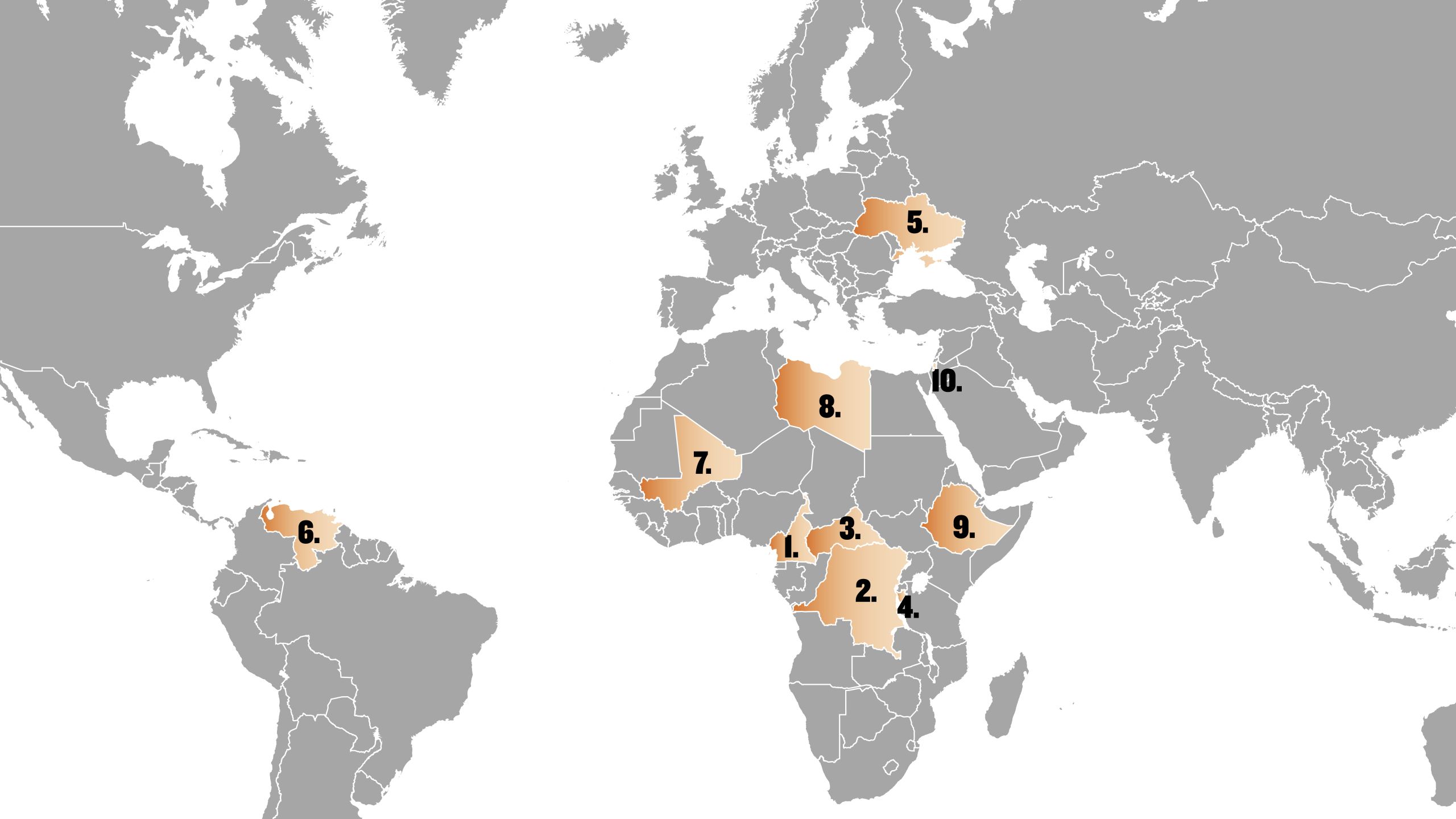
List of the most neglected displacement crises. 1. Cameroon 2. The Democratic Republic of the Congo 3. The Central African Republic 4. Burundi 5. Ukraine 6. Venezuela 7. Mali 8. Libya 9. Ethiopia 10. Palestine
Lack of political will. This includes both a lack of political will among armed parties on the ground to protect the rights of civilians and engage in peace negotiations, and the international community's unwillingness or inability to find political solutions.
The existence of a peace process, a decrease in the number of displaced people, and other positive developments are used here as indicators of some level of political will. The lack of such processes, a deterioration of the situation for civilians, and increased displacement indicate the opposite.
Lack of media attention. Various factors determine whether or not a crisis receives media coverage. The level of media attention is not necessarily proportional to the size of the crisis. Even when the media does report on a conflict, the situation for civilians may be overshadowed by coverage of war strategies, political alliances and fighting between armed groups.
When developing our list, we measured media attention in 2018 using Meltwater’s media monitoring figures. To compare media attention with the size of a displacement crisis, we divided the potential media reach of articles about the crisis, by the number of people displaced.
Lack of economic support. Every year, the UN and its humanitarian partners create funding appeals to cover people’s basic needs in countries affected by large crises. But, the extent to which these appeals are met varies greatly. We used the percentages of the appeals raised in 2018 to indicate levels of economic support. However, it should be noted that the real picture may be skewed by a tendency to ask for less funding for a crisis when there is an understanding that it is next to impossible to attract the actual amount required.
*Due to lack of information and reliable figures, we have not been able to analyse the situation in China and North Korea.

List of the most neglected displacement crises. 1. Cameroon 2. The Democratic Republic of the Congo 3. The Central African Republic 4. Burundi 5. Ukraine 6. Venezuela 7. Mali 8. Libya 9. Ethiopia 10. Palestine
List of the most neglected displacement crises. 1. Cameroon 2. The Democratic Republic of the Congo 3. The Central African Republic 4. Burundi 5. Ukraine 6. Venezuela 7. Mali 8. Libya 9. Ethiopia 10. Palestine
1: CAMEROON
Large-scale displacement and soaring humanitarian needs in the English-speaking parts of Cameroon have been met with deafening silence.
The crisis in the English-speaking parts of Cameroon started with peaceful protests in late 2016, but has escalated into a violent conflict between the government military and non-state armed groups. More than 450,000 people have been displaced as a result of the crisis. 780,000 children are out of school. Hundreds of villages have been burned down, tens of thousands of people are hiding in the bush with no humanitarian support and new attacks are taking place every day.
When brutal fighting displaces hundreds of thousands of civilians, it usually sets international alarm bells ringing. But this does not seem to apply to Cameroon. There has been no successful mediation and little pressure on the parties to stop attacking civilians.
Colonial roots. The crisis has some of its roots in Cameroon’s colonial history. After World War One, the German colony was split into French and British mandates. When the French part received independence in 1960, people in the British Northern Cameroons and Southern Cameroons were given a choice of merging with Nigeria or with French-speaking Cameroon, and Southern Cameroons chose the latter.
Present-day Cameroon has both French and English as official languages, but people in the English-speaking part of the country are feeling increasingly marginalised.
In 2016, one of the issues bringing people to the streets was the posting of French-speaking teachers in English-speaking regions. This promoted a heavy crack-down on protesters by security forces and led to widespread violence. A year later, non-state armed groups in the region officially declared a symbolic independence from Cameroon, and this has been followed by clashes between the Cameroonian army and the secessionist groups. Both parties have been accused of horrific human rights violations.
Humanitarian needs not being met. Despite the scale of the crisis, there have been almost no international journalists reporting from the affected areas. The lack of information and international political attention has allowed the situation to deteriorate from peaceful demonstrations to the atrocities currently being committed by both sides.
The lack of media attention has been matched by a lack of humanitarian funding. Of the 4 million people affected by the crisis in the English-speaking parts of Cameroon, 1.3 million are in need of assistance. Many have received no support.
Three crises. The country is also affected by another two crises: a displacement crisis in the north as a result of Boko Haram’s violence, and a refugee crisis in the east, where a large number of people from the Central African Republic have sought protection.
Of the USD 320 million needed to respond to these crises in 2018, according to the UN humanitarian appeal, only 44 per cent was raised. Now humanitarian organisations fear that the increased needs and a much needed scale-up of the response in the English-speaking regions may lead to already meagre funds being shifted from the neglected and protracted crises in the north and the east.
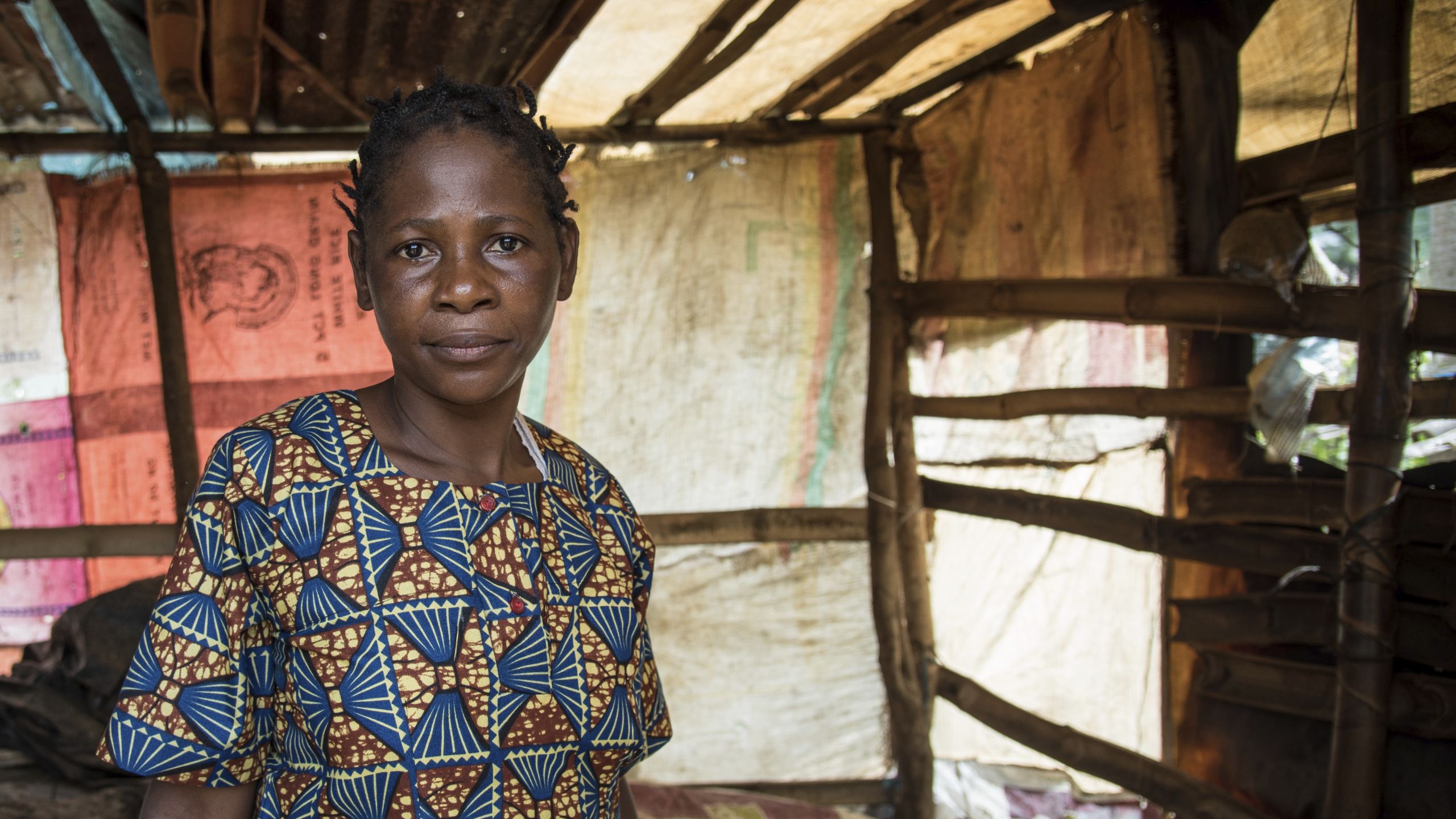
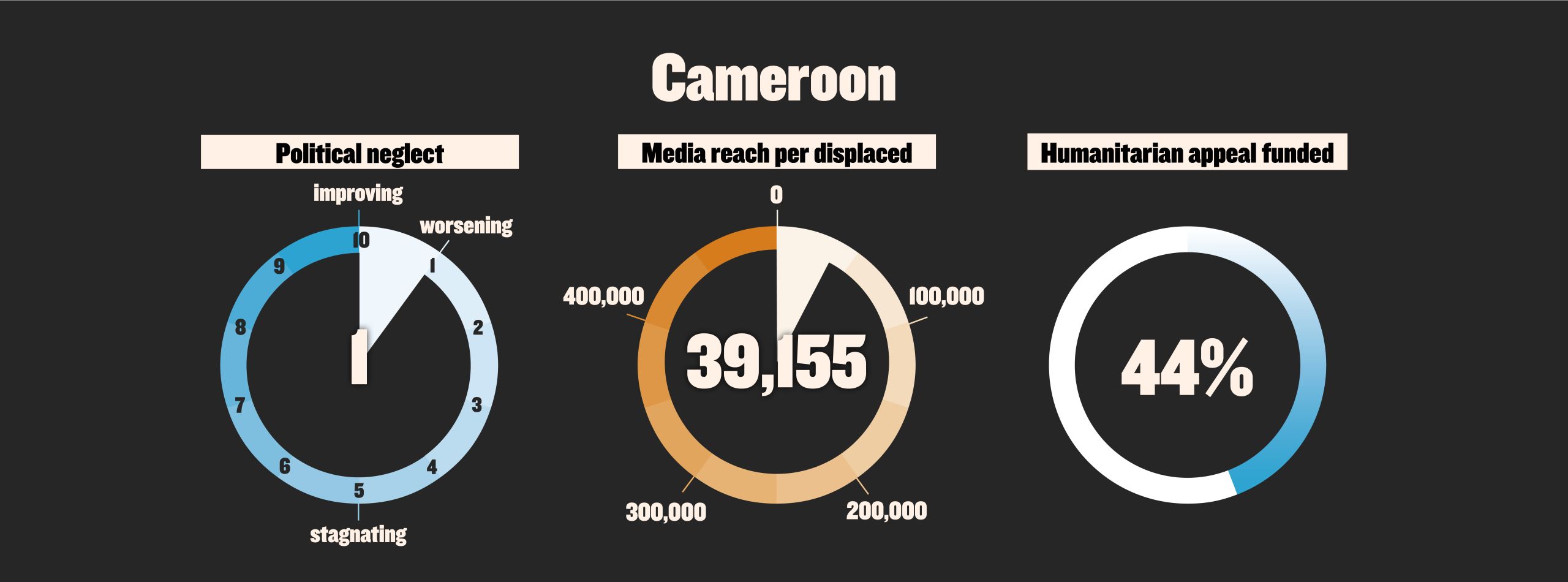
2: DR CONGO
Hundreds of thousands of Congolese were forced to flee across Lake Albert into Uganda in 2018, when inter-ethnic fighting resumed in the north-eastern provinces of North Kivu and Ituri. Meanwhile, around 1 million people were displaced internally, within the two provinces.
Fighting between armed groups over control of territory and resources, destruction of schools and homes and attacks on civilians created significant humanitarian needs. To compound this already complicated crisis, an outbreak of Ebola was declared in August 2018.
While conflict and disease raged in the east, there was a gradual de-escalation of violence in the Greater Kasai region and in Tanganyika province, the epicentres of the humanitarian crisis in 2017. More than 1.3 million people returned to their places of origin in the Greater Kasai region alone.
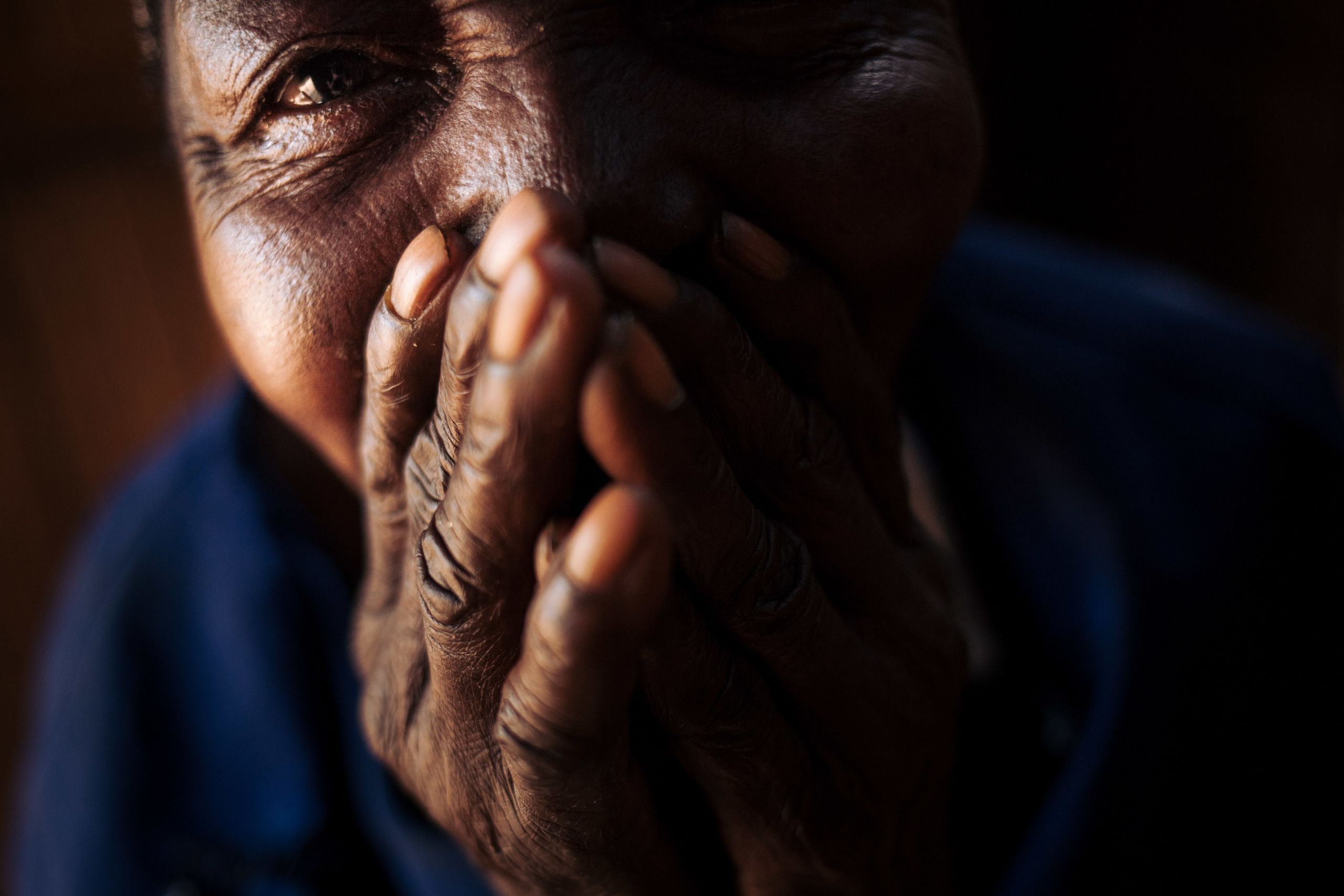
Photo: Aléxis Huguet/NRC
Still, many were unable to cover their basic needs. A total of 770,000 children were suffering from malnutrition in Greater Kasai because of a lack of food last year, according to UNICEF. The UN also reported a 70 per cent increase in acute hunger between 2017 and 2018 across the country.
International attention and donor funding have not kept up with the escalating needs. An international donor conference held in April 2018 failed to raise sufficient funds, and by the end of the year donors had contributed less than half of the money needed for the humanitarian response. International media attention throughout the year focused mainly on the outcome of the delayed presidential election and the Ebola outbreaks – pushing one of the worst humanitarian crises on the planet further and further into the shadows of the world’s consciousness.

Photo: Aléxis Huguet/NRC
Photo: Aléxis Huguet/NRC
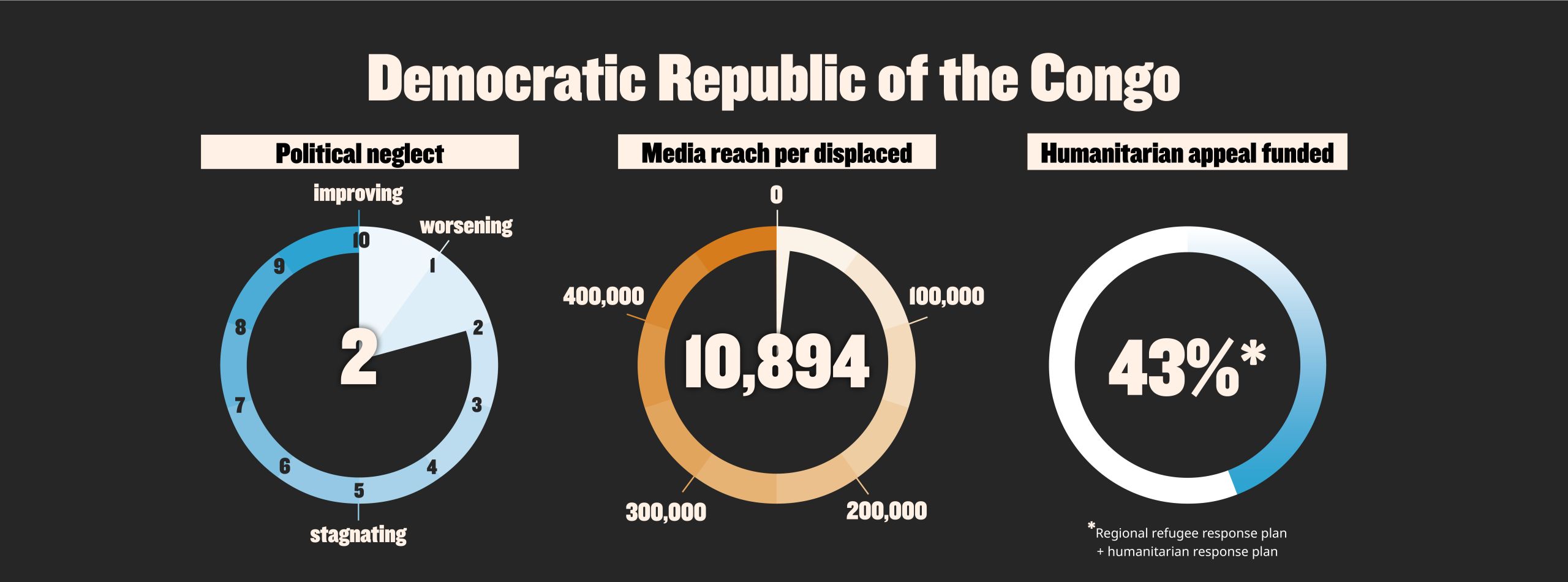
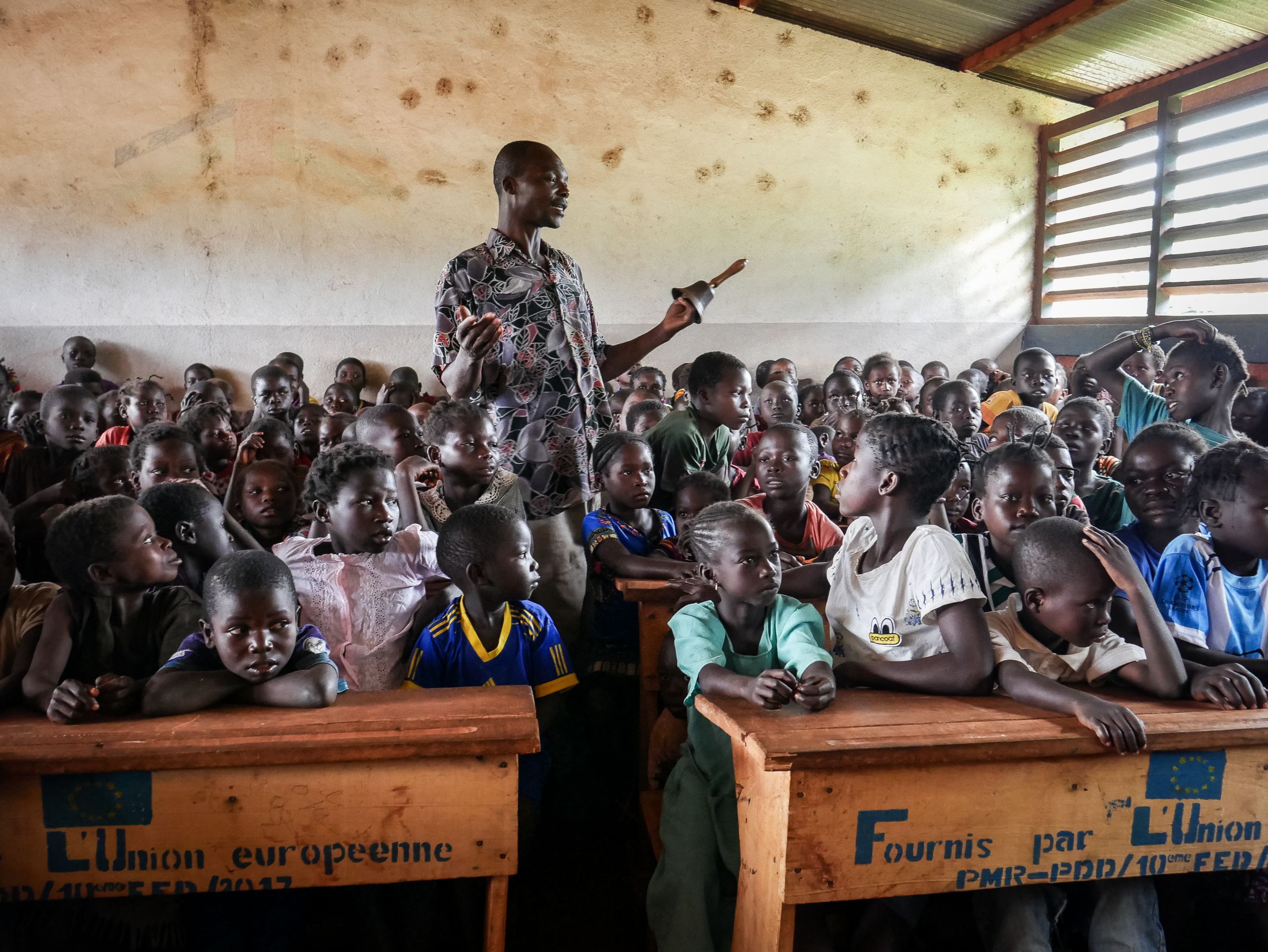
Photo: Hajer Naili/NRC
Photo: Hajer Naili/NRC
3: CENTRAL AFRICAN REPUBLIC
A quarter of the population of the Central African Republic (CAR) has been displaced, either within the country or to neighbouring countries. 2.9 million of the country’s 4.6 million inhabitants are in urgent need of humanitarian support.
It is one of the world’s worst crises, in terms of the percentage of the population affected.
Still, the crisis goes largely underreported and the humanitarian response is among the most underfunded. These characteristics have placed CAR near the top of the neglected crisis list year after year.

Photo: Hajer Naili/NRC
Local armed groups control most of the country, and repeated outbreaks of violence continue to force people from their homes. Clashes between armed groups have created vicious cycles of revenge attacks, while religion is being manipulated to incite conflict between communities.
Simultaneously, criminality is on the rise. Aid workers have been regularly attacked and intimidated, forcing some aid agencies to suspend their operations or pull out of certain areas. Last year, CAR recorded the world’s highest number of security incidents against aid organisations.
In late 2018, armed groups deliberately targeted and burned down several sites for displaced people in Alindao and Batangafo. Hundreds of civilians, including women and children, were killed, while several thousands were again forced to flee.
Some political initiatives have been taken to bring the armed groups to the negotiating table. However, despite a peace deal signed in Khartoum by 14 armed groups and the CAR government in February 2019, violence has continued across the country and insecurity is likely to persist.
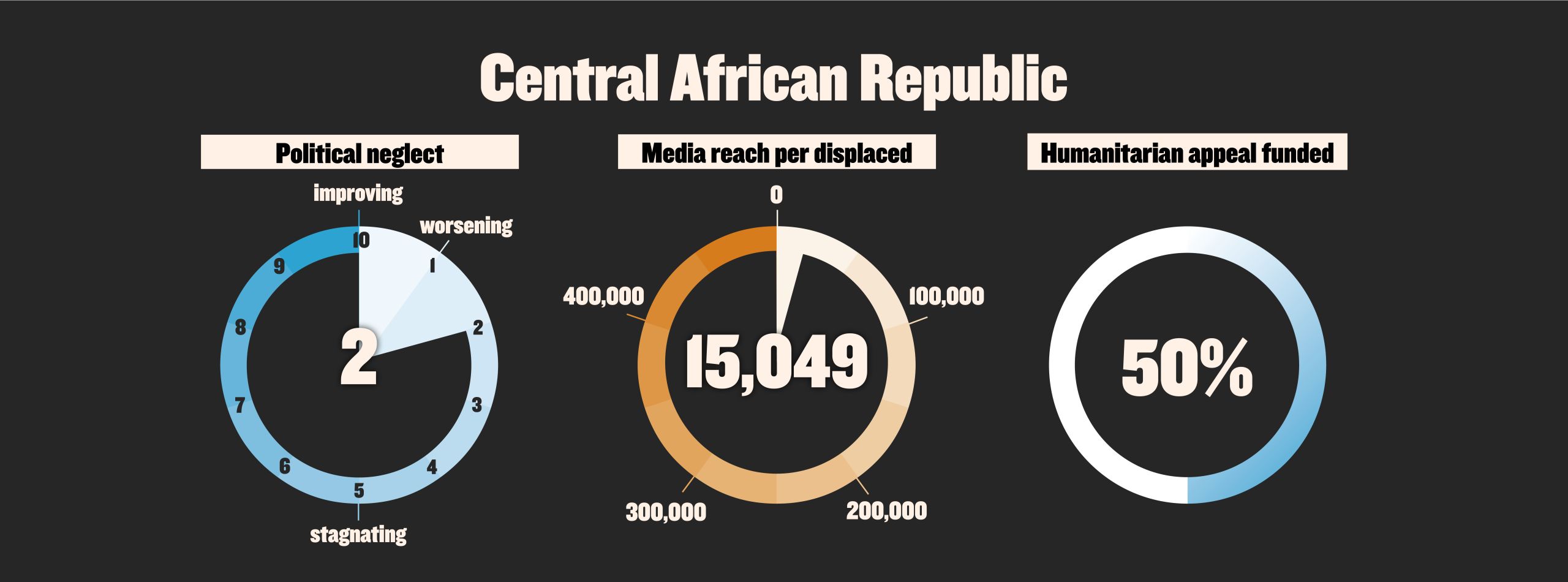
4: BURUNDI
When President Pierre Nkurunziza announced plans to run for presidency for a third term in 2015, street protests turned into violent clashes. The police responded brutally to the political unrest and between 400,000 and 500,000 Burundians fled in search of safety to nearby countries.
Some have since returned home, despite the tense situation in Burundi, but four years after violence first broke out, more than 350,000 refugees are still living in displacement.
Most Burundian refugees sought safety in neighbouring Tanzania, while others fled to Rwanda, Uganda and the Democratic Republic of the Congo. Due to a lack of media attention and inadequate funding from the international community, Burundian refugees are unable to cover their most basic needs. They live in overcrowded camps, don’t have enough to eat, and are threatened by waterborne diseases.
In 2018, only 33 per cent of the humanitarian appeal for Burundian refugees was funded. This funding gap makes it the lowest-funded refugee crisis worldwide (UNHCR). The appeal to support people affected by the humanitarian crisis inside Burundi itself was also severely underfunded.
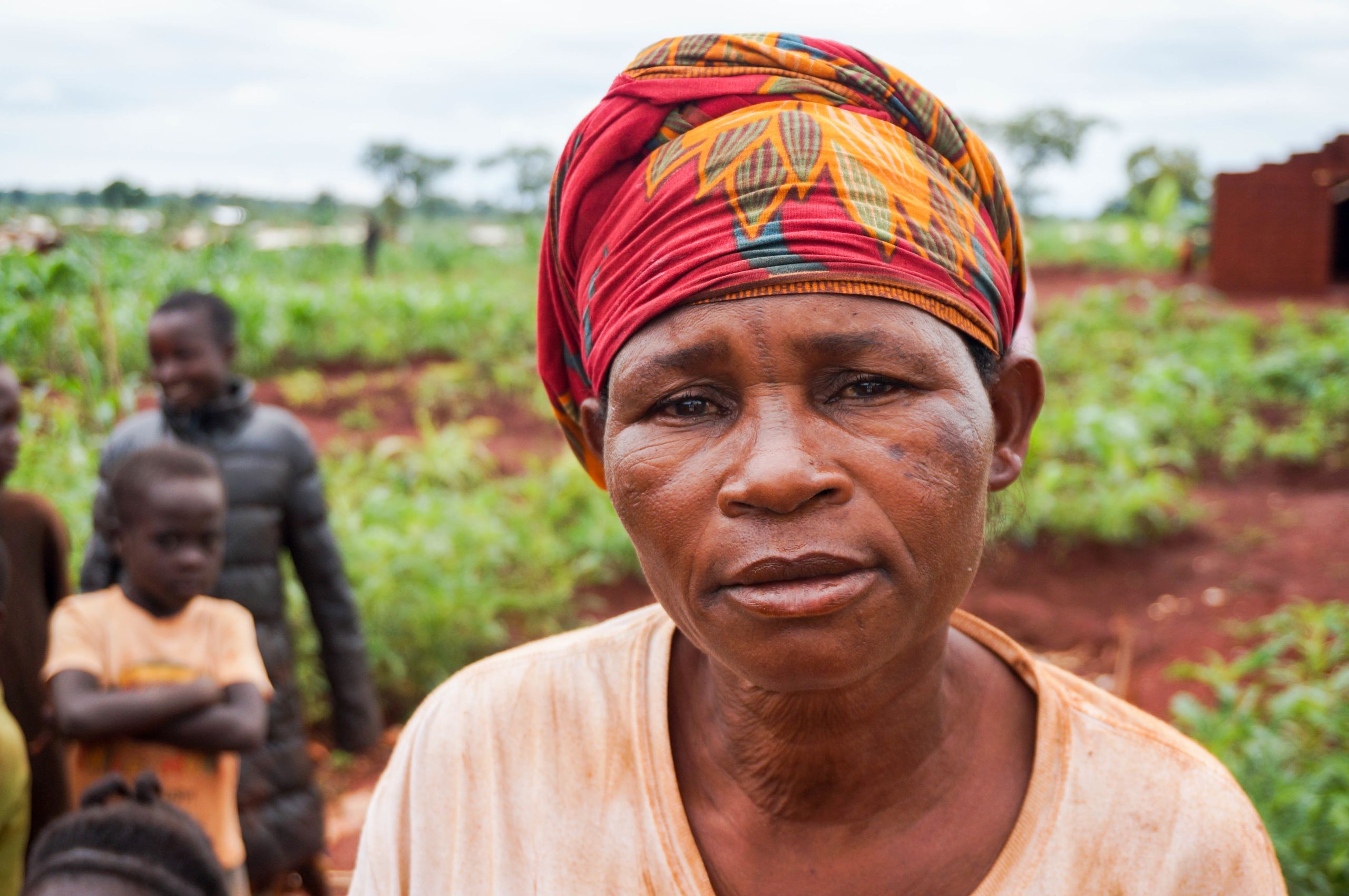
Photo: Guri Romtveit/NRC
Tanzania has generously hosted many Burundian refugees over the past years, but in January 2018 the country withdrew from the Comprehensive Refugee Response Framework (CRRF) and said it would discourage new asylum seekers from coming. Many refugees feel that they are under pressure to return, but that it is still too dangerous to go back home.

Photo: Guri Romtveit/NRC
Photo: Guri Romtveit/NRC
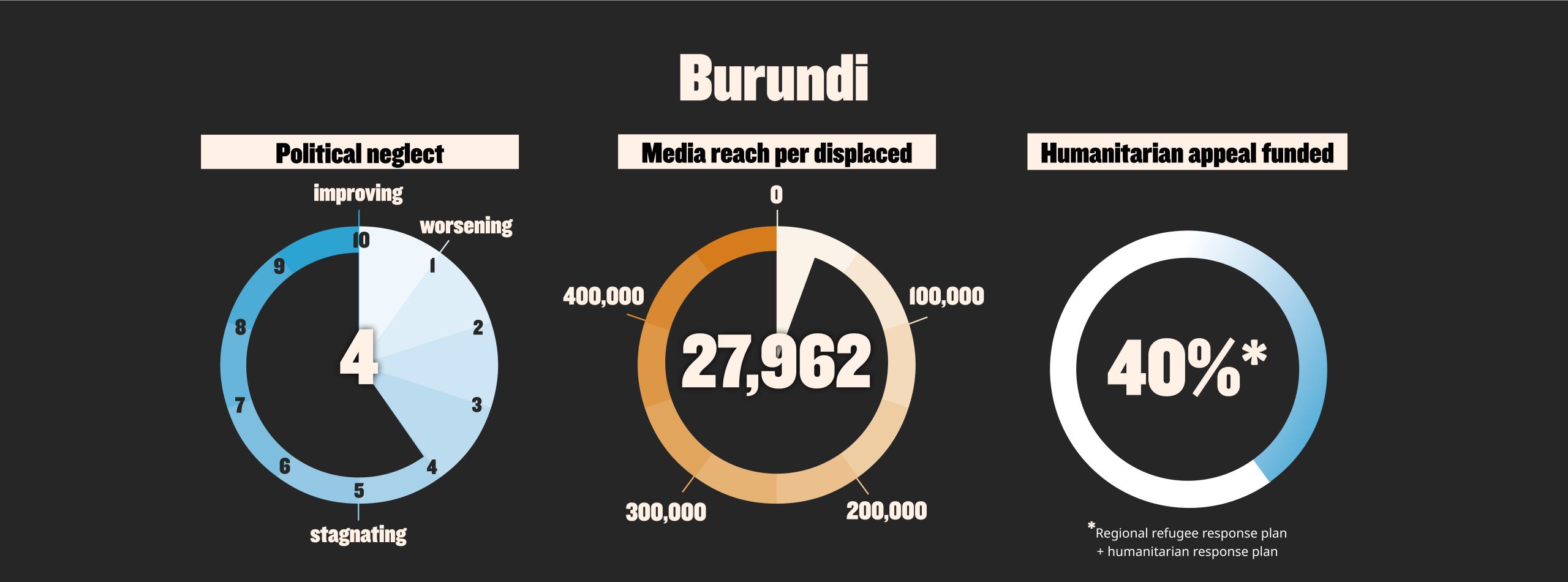
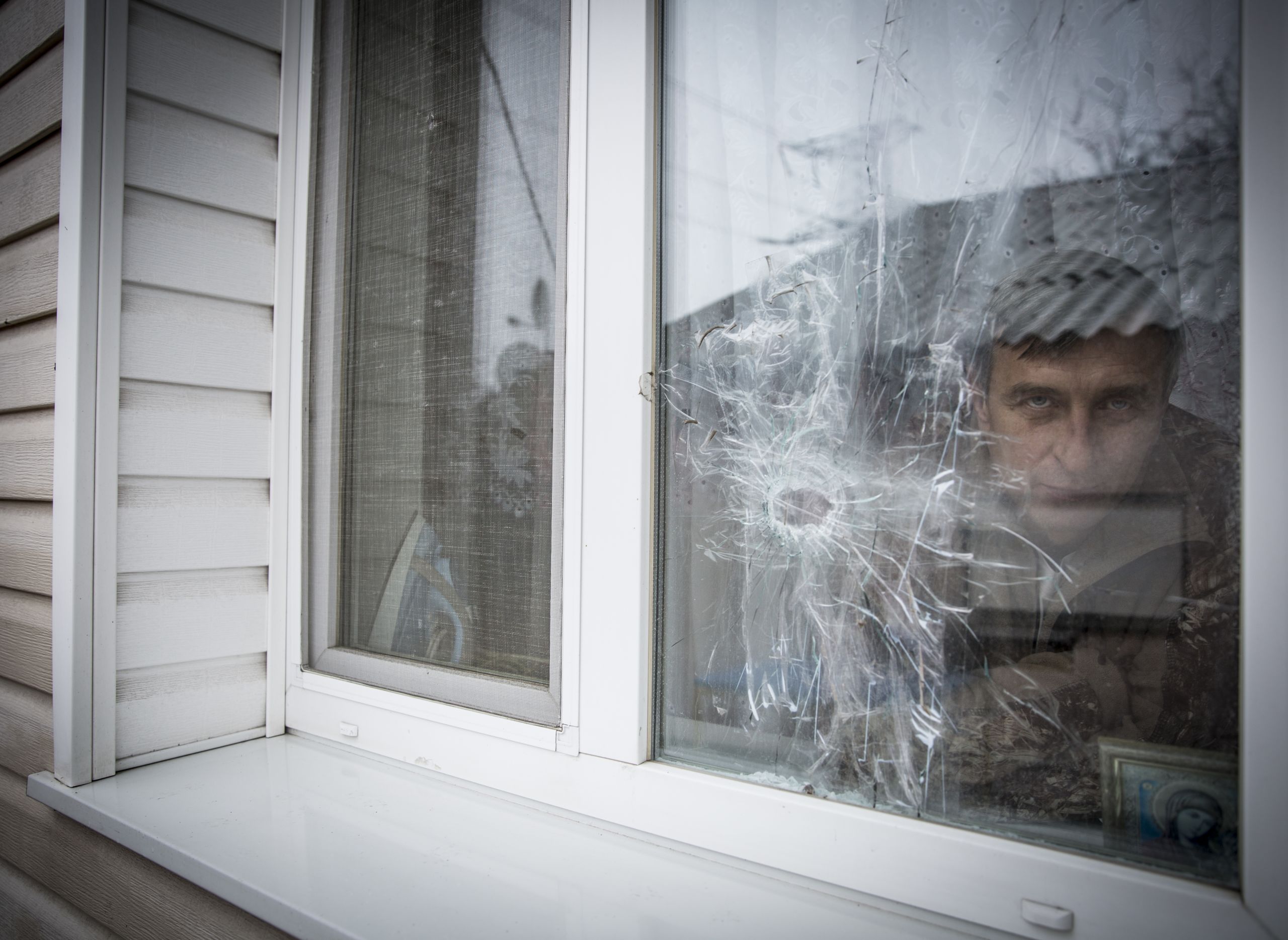
Photo: Ingebjørg Kårstad/NRC
Photo: Ingebjørg Kårstad/NRC
5: UKRAINE
Now in its sixth year, the armed conflict in Ukraine continues with no real solution in sight for the 5.2 million people affected. Around 800,000 people remain permanently displaced within the country, according to the Internal Displacement Monitoring Centre.
Hostilities along the frontlines continue to damage civilian infrastructure. Water and sanitation facilities have been cut off, children have lost access to their schools, and families have seen their homes destroyed. Although five ceasefire recommitments came into effect during 2018, resulting in some reduction in casualties, they were all short-lived. Armed conflict remains a daily reality for millions of people living close to the frontlines.

Photo: Ingebjørg Kårstad/NRC
Most at risk are the civilians on both sides of the 427-kilometre- long contact line in eastern Ukraine, that separates government- controlled areas from non-government-controlled areas. These civilians face shelling, violent clashes, landmines and unexploded bombs. Women, men, children and elderly people are forced to wait for hours at checkpoints, in the severe cold or under the scorching summer sun, in order to cross to the other side.
Last year’s humanitarian response plan was only 37 per cent funded, making it one of the most severely underfunded appeals. This means that only 1.1 million people received protection and assistance, out of the 3.4 million in need. The conflict is no longer making headlines and is fading from people’s minds.
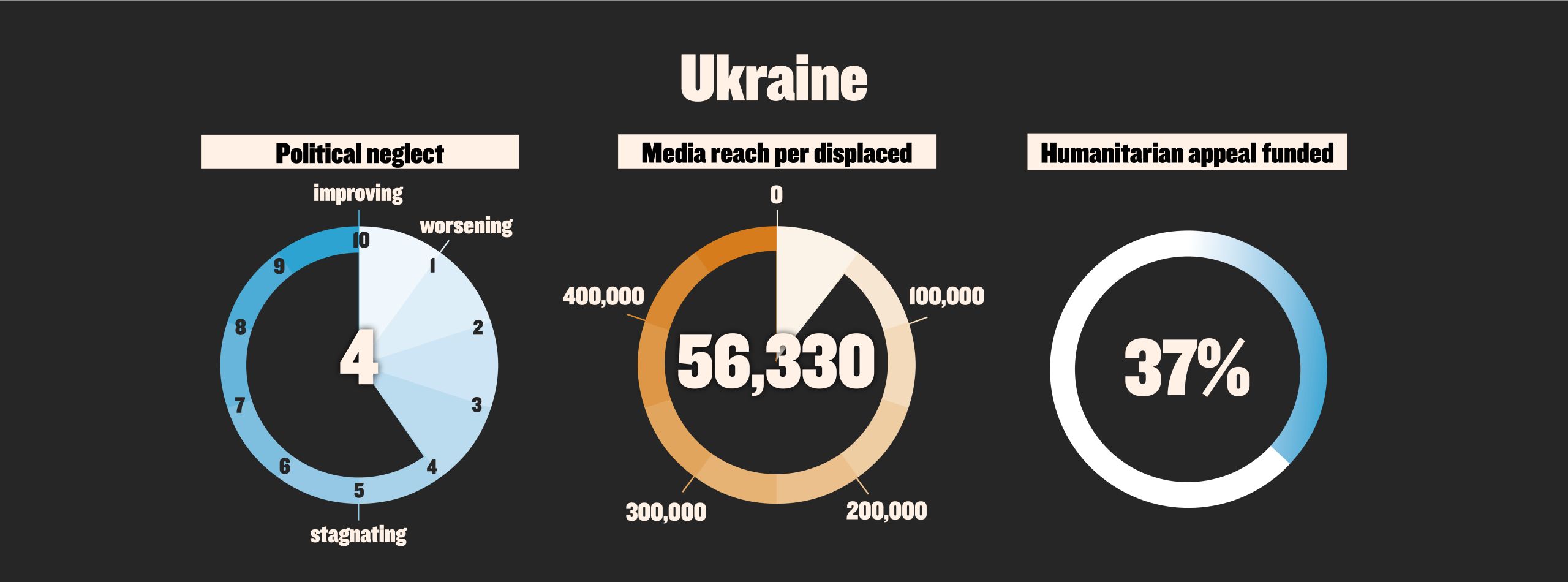
6: VENEZUELA
A combination of acute socio-economic crisis and a lack of political solutions led to deteriorating conditions inside Venezuela in 2018 and large-scale population movements.
An estimated 7 million people are in need of humanitarian assistance in Venezuela, according to the UN. Food is less available and affordable, and many people now depend on the delivery of subsidised food to meet their needs. The UN Food and Agriculture Organization estimates that around 3.7 million Venezuelans suffered from undernourishment in 2018.
Around 3.4 million refugees and migrants have already left the country, with 2.7 million of them currently living in Latin America and the Caribbean countries, according to the International Organization for Migration (IOM).
The long and challenging migration route has left displaced Venezuelans with major needs. One of the most crucial challenges they face is obtaining some form of official status that allows them to get a job, send their children to school, and access important services like healthcare. Having official status also means that people are less vulnerable to trafficking, labour exploitation and other abuses that are detrimental not only to migrants but to the communities they join.
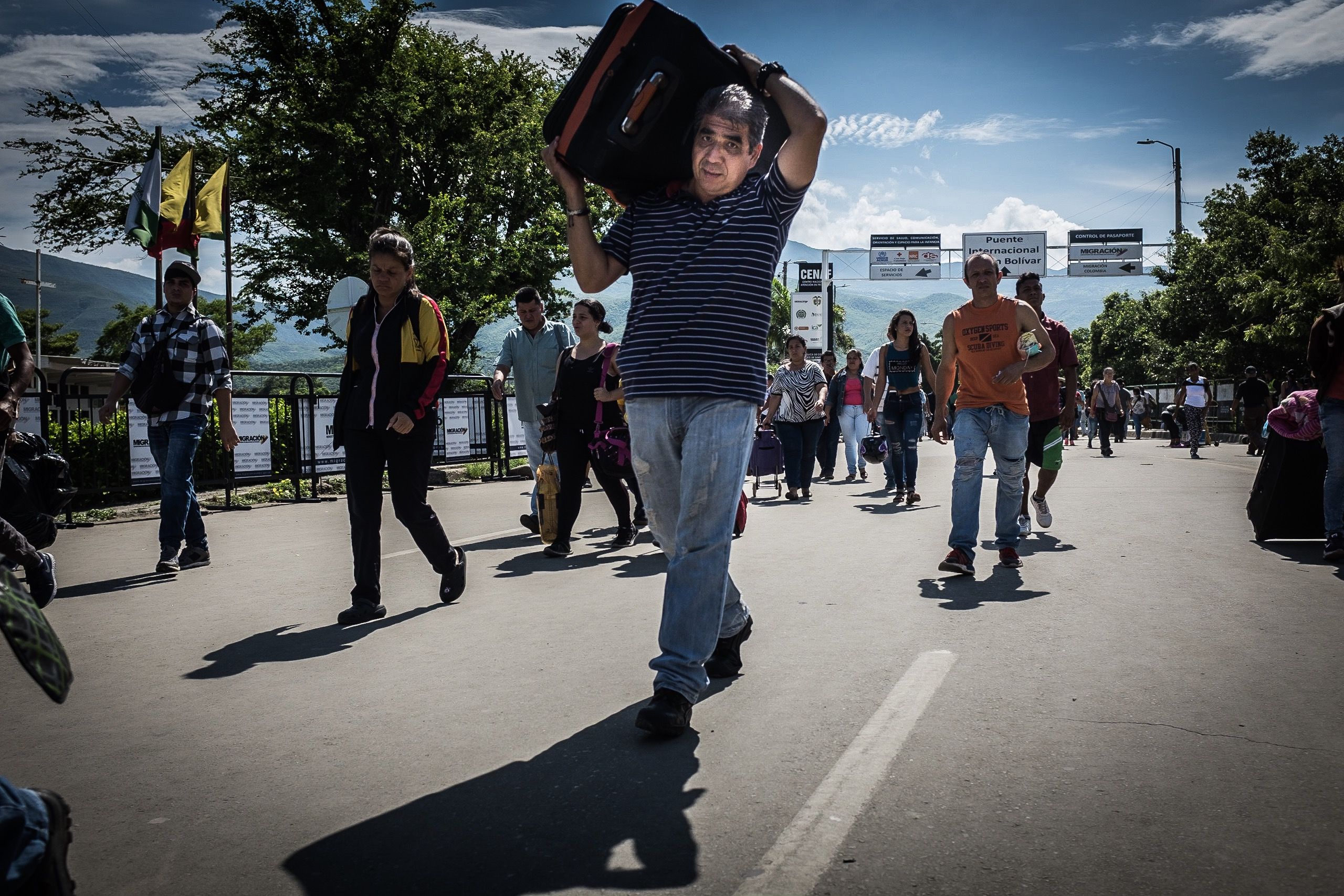
Photo: Adam Combs/NRC
With stretched resources and an increasing number of arrivals, the risk of discrimination and xenophobia is increasing. The humanitarian response in the region continues to be insufficient in its speed and scale and there is a common concern about the lack of resources to respond to the situation as it develops.
The political game in Venezuela has received a lot of attention, and many countries have an interest in how it develops. However, those involved have so far shown little willingness to compromise.

Photo: Adam Combs/NRC
Photo: Adam Combs/NRC
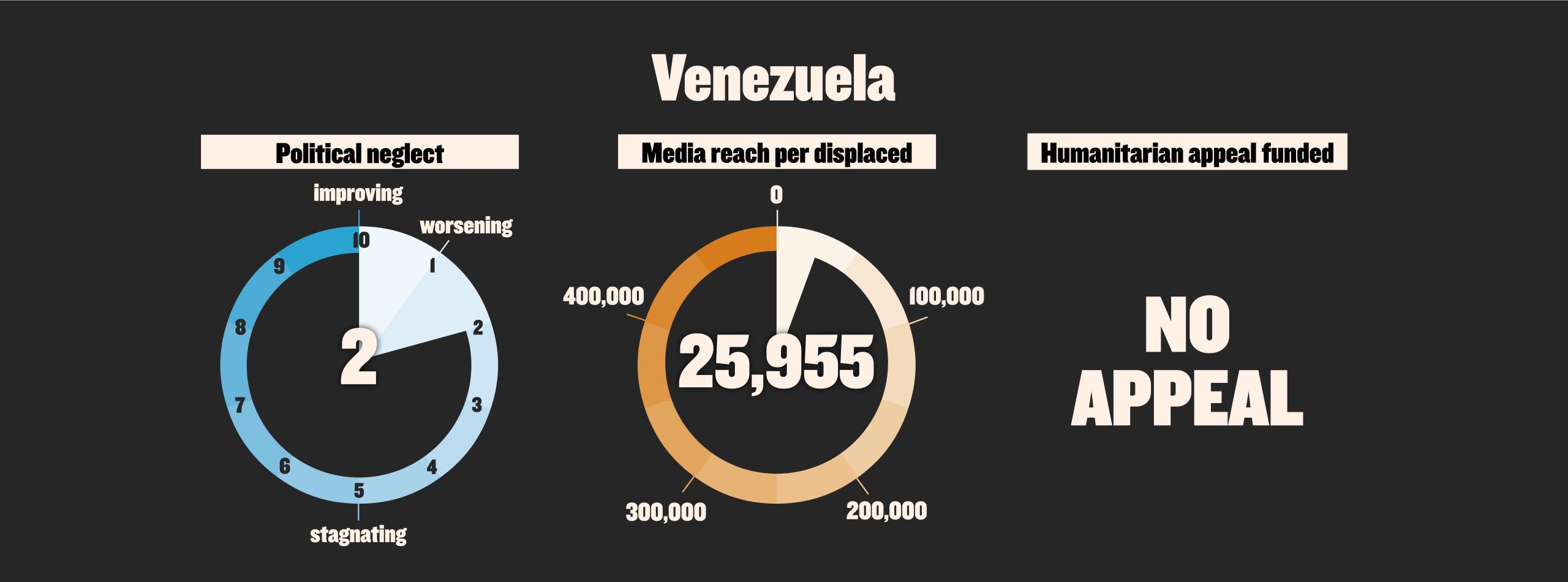
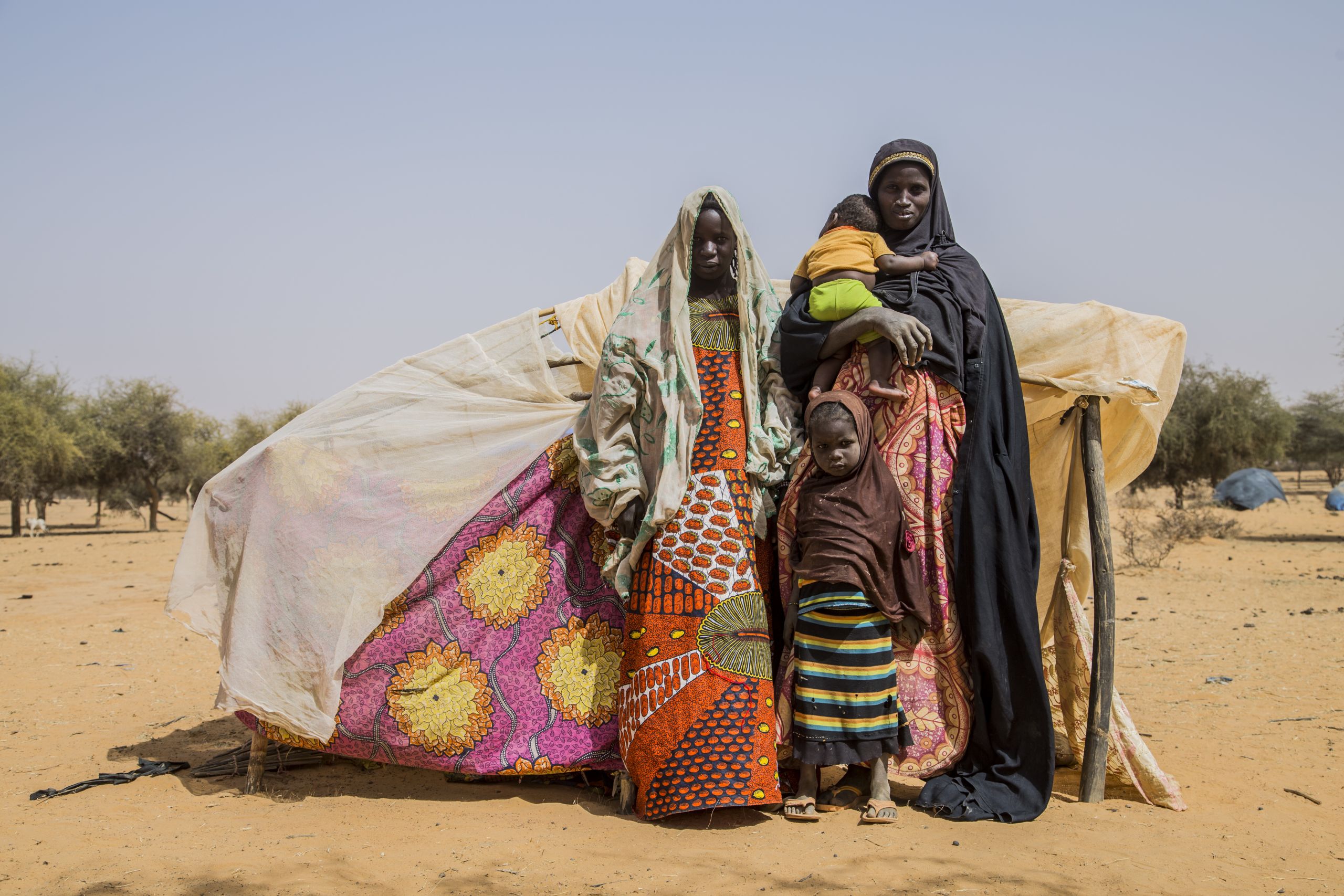
Photo: Togo Moise/NRC
Photo: Togo Moise/NRC
7: MALI
While massive military resources are being poured in to stabilise central and northern regions of Mali, local conflicts and tensions between communities have increased, exacerbating the humanitarian crisis.
The number of people displaced more than tripled during 2018, from 35,000 to 126,000, and has continued to increase during the early part of 2019. The figure is now higher than at any point since the signing of the peace deal in 2015. This alarming trend of escalating displacement is mostly due to attacks by non-state armed groups, threats and intimidations, inter-communal conflicts and military operations.
Fatalities linked to direct attacks on civilians are also on the rise, according to the Armed Conflict Location & Event Data Project (ACLED). Increased insecurity has led to the closure of more than 800 schools across the country. This has deprived 250,000 children of access to formal education, thus increasing the risk of abuse and exploitation, including by armed groups.
Still, the deepening humanitarian crisis has received limited media attention. When the situation in Mali has been covered, the stories have mostly focused on military activities.

Photo: Togo Moise/NRC
The unexpected increase in needs, combined with a severely underfunded humanitarian appeal, have meant that many people have received no assistance. The massive resources being invested in military operations in the Sahel region of Africa have not been matched with a similarly ambitious humanitarian funding strategy. The need to address socio-economic issues such as poverty, poor governance, corruption and a declining ecosystem is also overshadowed by the current security agenda.
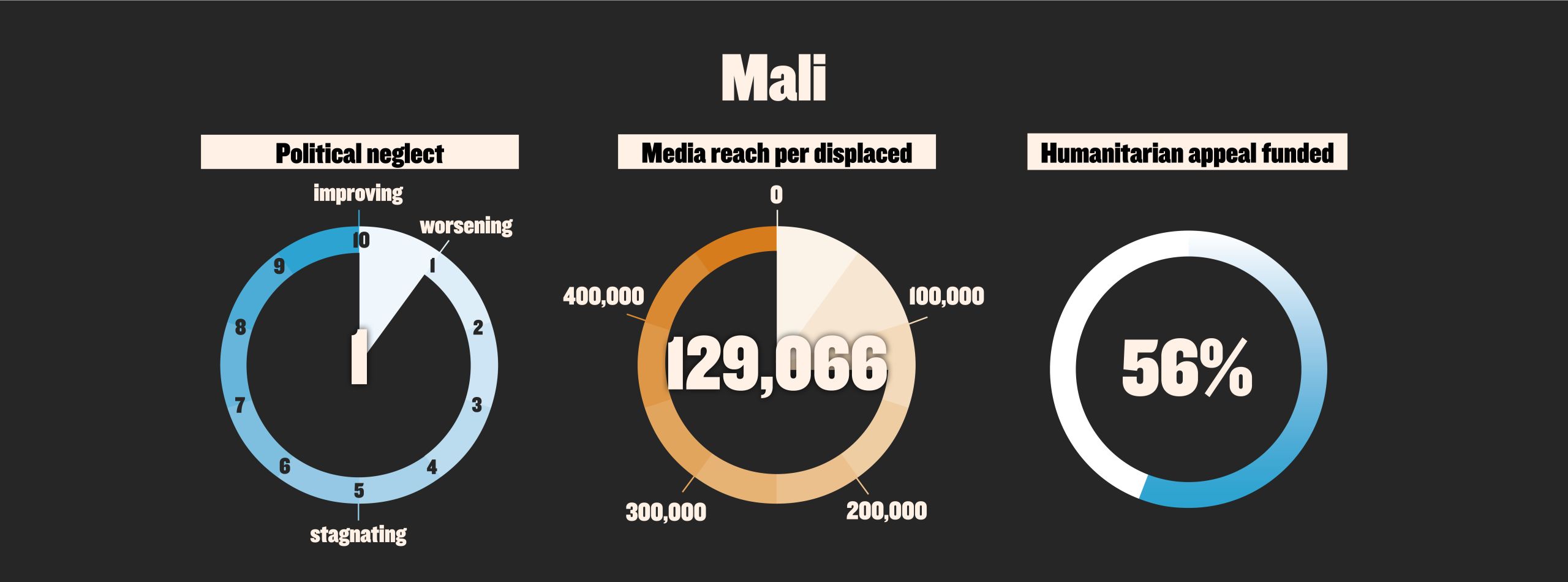
8: LIBYA
Years of political instability in Libya have steadily eroded governance structures, weakened state institutions and damaged the nation’s economy. As a result, one in ten people are in need of humanitarian assistance.
Since 2011, which saw the departure of Colonel Muammar Gaddafi after more than four decades in power, a breakdown in law and order has created a security vacuum and a proliferation of armed violence. While the pace of displacement slowed through 2018, indiscriminate attacks, localised clashes, extrajudicial killings and arbitrary detentions from preceding years left 221,000 people displaced by the end of the year.
The humanitarian appeal for Libya was only 26 per cent funded last year, making it the least well-funded of all the countries in this year’s neglected crisis list. Of the 823,000 people in need of humanitarian assistance, around half are Libyan citizens and half are refugees and migrants from other countries. The latter group are particularly vulnerable to rights violations and extreme violence including various forms of gender-based violence, robbery, extortion, forced labour, kidnapping, disappearances and killings. The direct and indirect impact of violence has had severe implications for people in Libya. Many have experienced physical harm, psychological distress and trauma.
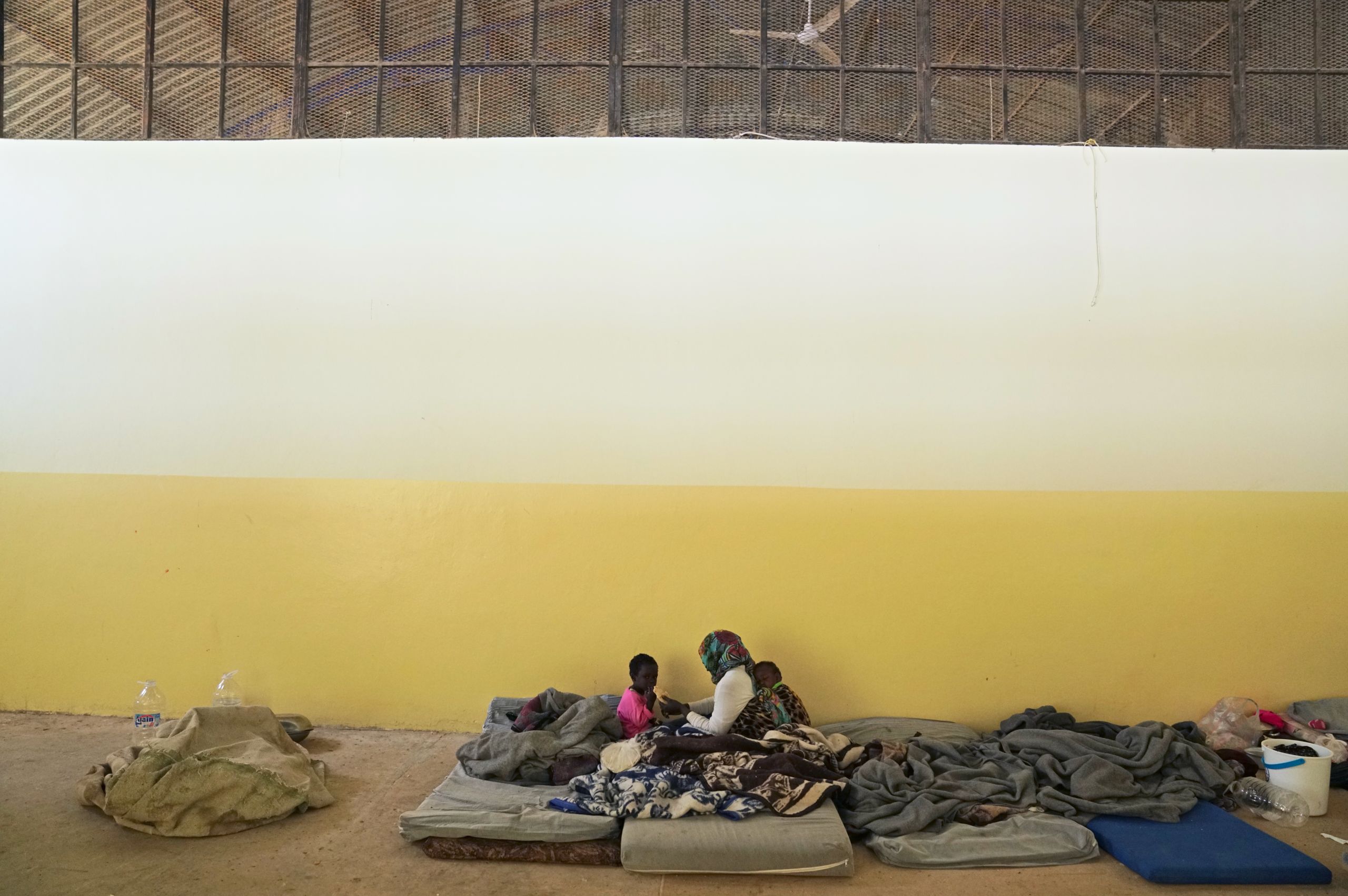
Photo: Giles Clarke/UNOCHA
In recent years, global attention has focused predominantly on Libya’s position as a major transit country for migrants seeking to cross the Mediterranean for protection and economic opportunities in Europe. However, this attention has failed to prompt action geared towards improving safety and stability within the country.
While the number of people crossing the Mediterranean has reduced, those migrants currently in Libya are left with very few adequate or humane means to secure their survival. Substantive support for Libyan institutions is vital to enable the country to protect all people within its borders – both Libyan and non-Libyan.

Photo: Giles Clarke/UNOCHA
Photo: Giles Clarke/UNOCHA
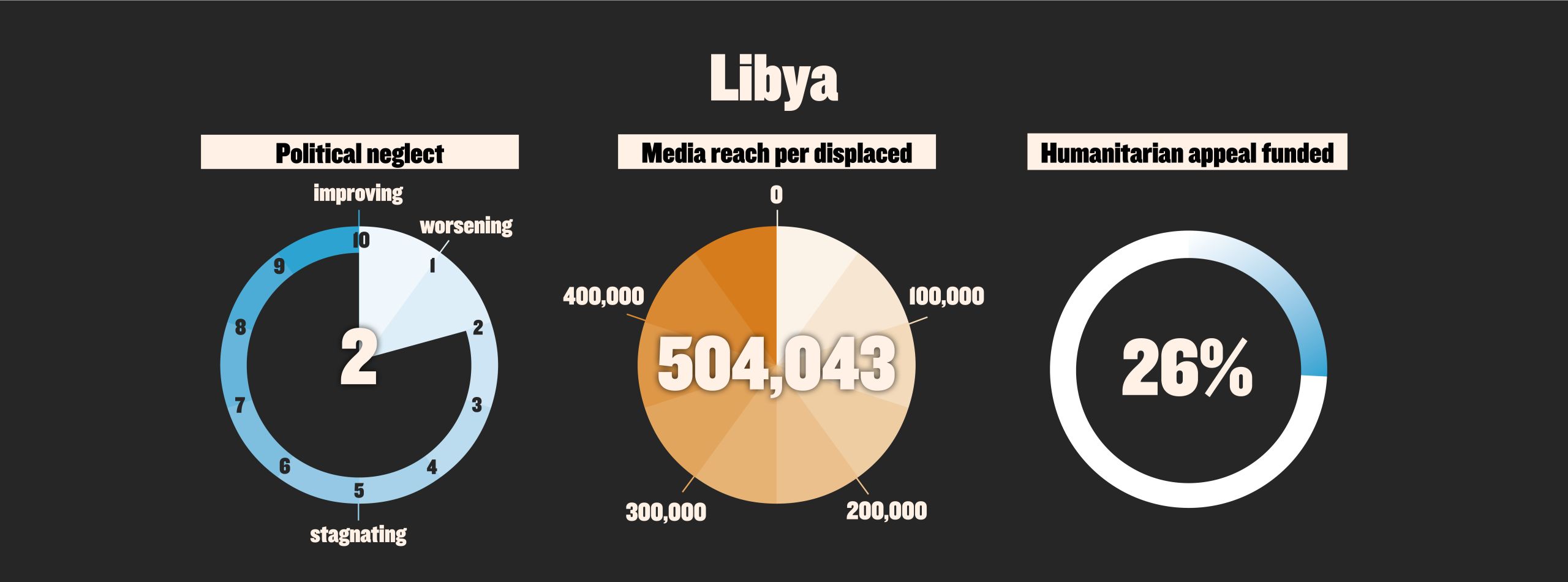
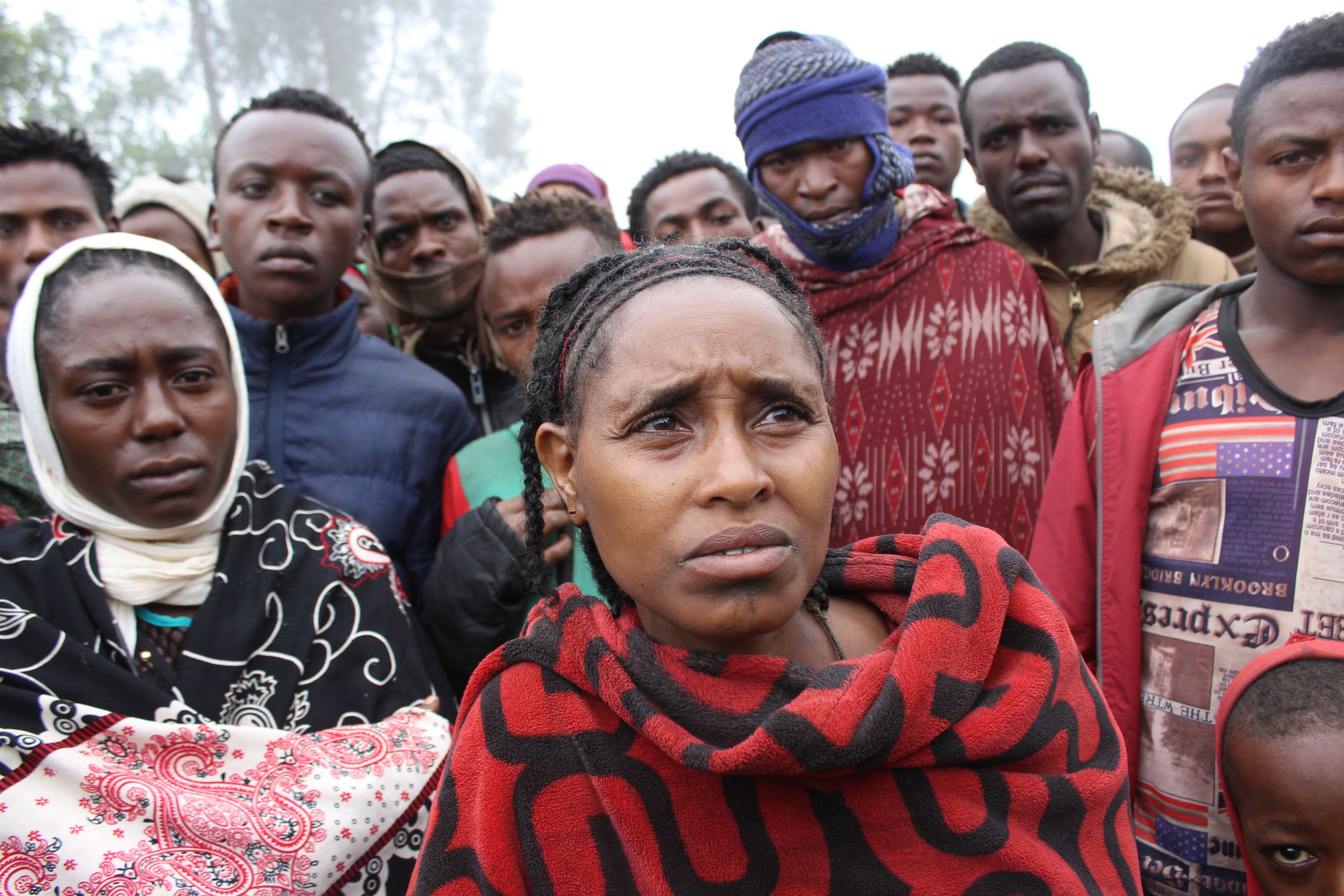
Photo: Nashon Tado/NRC
Photo: Nashon Tado/NRC
9: ETHIOPIA
Despite several positive political developments, inter-communal violence and conflicts have deepened since 2016, and escalated significantly last year. This resulted in more than 2.9 million displacements within Ethiopia, the highest number of new internal displacements globally.
Displaced families are living in grim conditions and hundreds of thousands are struggling to find space in overcrowded centres such as schools and churches. While some people have returned to their homes, many do not feel it is safe and see return as premature.
The internal conflicts, combined with drought, have exacerbated an already dire food situation. More than 8 million people were in need of food assistance last year. The humanitarian appeal for support was only 56 per cent funded, and many people received no or limited assistance.

Photo: Nashon Tado/NRC
Sweeping reforms led by President Abiy Ahmed and a peace agreement with neighbouring Eritrea continue to generate positive media attention from around the globe, but the growing displacement crisis in Ethiopia remains largely hidden from view.
Ethiopia is also home to over 900,000 refugees from other countries, primarily neighbouring South Sudan, Somalia, Sudan and Eritrea. Following the UN’s Global Compact agreement on refugees last year, Ethiopia has approved a new law that gives refugees access to services such as education, civil documentation and banking. The law also allows limited access to work permits for refugees. This resulted in some well-deserved media attention, with the government gaining credit for its progressiveness and positive attitude towards refugees. However, successful implementation of the law will require effort both from the government of Ethiopia and from donors.
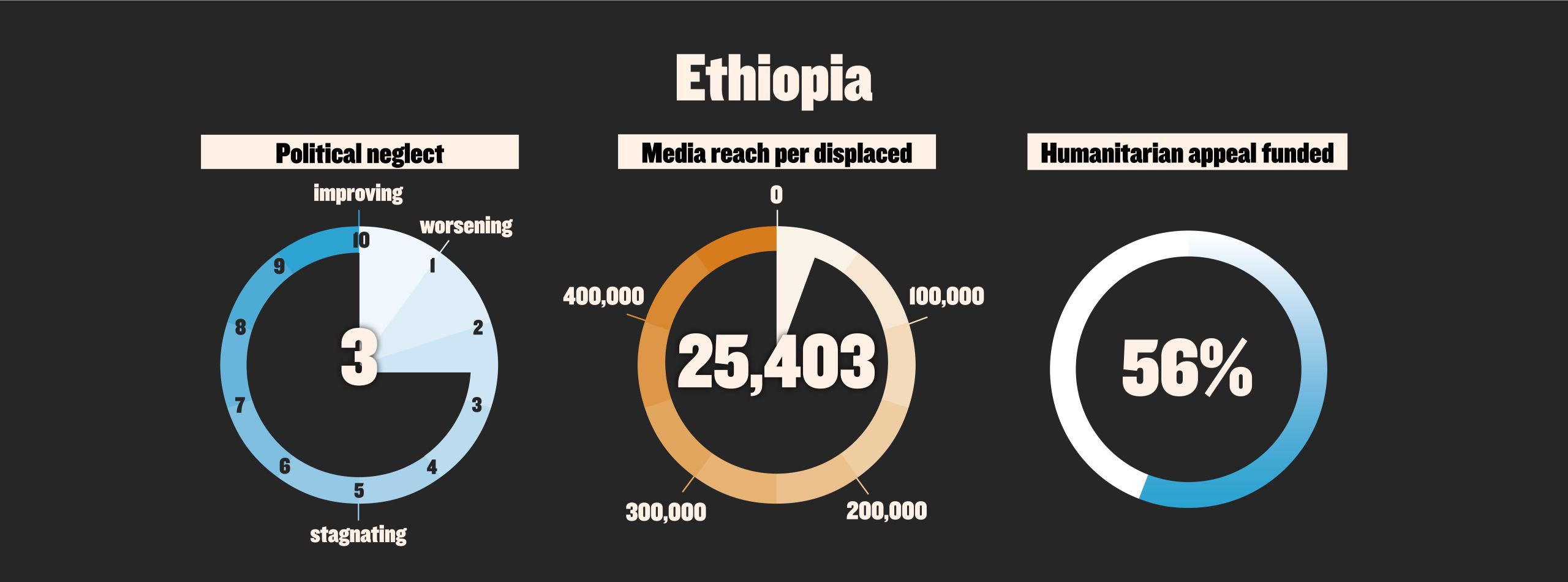
10: PALESTINE
Sustained violence, human casualties and overwhelming humanitarian needs demonstrate an alarming failure within the international community to find a political solution for Palestinian refugees. It is more than 70 years since the establishment of the state of Israel and the subsequent expulsion of hundreds of thousands of Palestinians. Today, 4.8 million people – the entire population of the occupied territory – are affected by protection risks, and half are in need of humanitarian assistance.
Palestine is an unusual inclusion in a neglected crisis list. Violations of international law and their humanitarian consequences are reported by the world’s media with some regularity, and the pursuit of a political solution remains – ostensibly – high on the agenda of many UN member states. Nevertheless, a political solution seems further away than ever before.
The situation for many Palestinians continues to deteriorate. In the Gaza Strip, the World Bank describes an economy in “free fall”, and basic services are crippled by power cuts for up to 20 hours a day. In the West Bank, legislation passed in 2018 threatens to strangle the ability of individuals and rights-based organisations to mount a legal challenge when Palestinian homes in certain areas are destroyed.
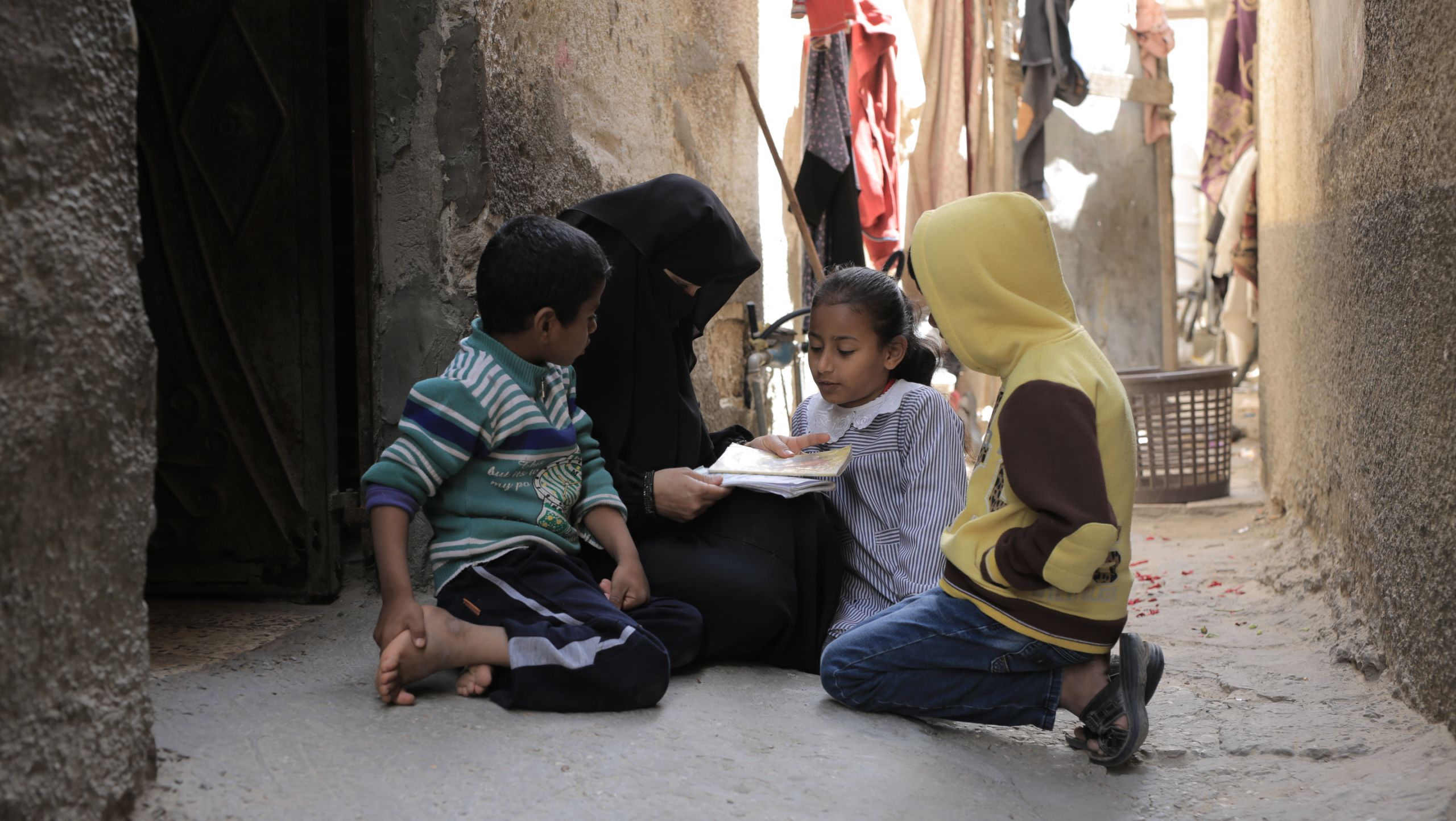
Photo: Ahmed Mashharawi/NRC
In 2018, against this backdrop of collapsing public services and a crumbling economy in the Gaza Strip, and an increasingly coercive environment for Palestinians in the West Bank and East Jerusalem, the United States government announced funding cuts of USD 200 million for bilateral aid to Palestine. The 2018 humanitarian appeal received just 45.7 per cent of the funding required to help the 2.5 million people in need.

Photo: Ahmed Mashharawi/NRC
Photo: Ahmed Mashharawi/NRC
